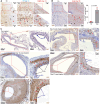Blockade of YAP Mechanoactivation Prevents Neointima Formation and Adverse Remodeling in Arterialized Vein Grafts
- PMID: 40118797
- PMCID: PMC12132867
- DOI: 10.1161/JAHA.124.037531
Blockade of YAP Mechanoactivation Prevents Neointima Formation and Adverse Remodeling in Arterialized Vein Grafts
Abstract
Background: Bypass surgery using saphenous vein (SV) grafts is commonly performed to revascularize the ischemic heart and lower limbs. These interventions have limited success due to adverse remodeling caused by overproliferation of smooth muscle cells in the intima layer, leading to progressive bypass stenosis. We previously showed that cyclic strain deriving from exposure to coronary flow induces the expression of the matricellular protein thrombospondin-1 in the human SV, promoting activation of progenitor cells normally residing in the adventitia.
Methods: We analyzed the data of an RNA-sequencing profiling of human SV progenitors subjected to uniaxial strain we previously performed by. Experiments in cell culture, ex vivo, and in vivo vein arterialization models were performed to substantiate findings with particular reference to the role of mechanically activated transcription factors. Validation was performed in vitro and in ex vivo/in vivo models of vein graft disease.
Results: Results of bioinformatic assessment of the RNA-sequencing data indicated Yes-associated protein (YAP) as a possible mechanically regulated effector in pathologic evolution of SV progenitors. Inhibition of YAP by verteprofin-a drug that abolishes the interaction of YAP with Tea Domain DNA-binding proteins-reduced the expression of pathologic markers in vitro and reduced intima hyperplasia in vivo.
Conclusions: Our results reveal that desensitizing the SV-resident cells to mechanoactivation of YAP is feasible to reduce the graft disease progression.
Keywords: TGF‐β; YAP; mechanical strain; vein graft disease; verteporfin.
Conflict of interest statement
None.
Figures






References
-
- Gaudino M, Benedetto U, Fremes S, Ballman K, Biondi‐Zoccai G, Sedrakyan A, Nasso G, Raman J, Buxton B, Hayward PA, et al. Association of radial artery graft vs saphenous vein graft with long‐term cardiovascular outcomes among patients undergoing coronary artery bypass grafting. JAMA. 2020;324:179–187. doi: 10.1001/jama.2020.8228 - DOI - PMC - PubMed
MeSH terms
Substances
LinkOut - more resources
Full Text Sources
Medical

